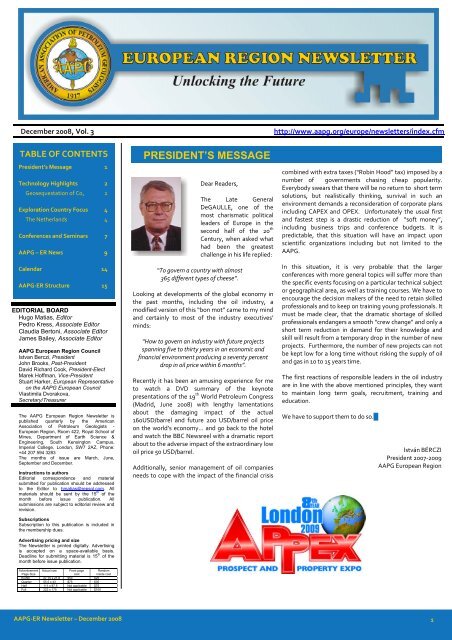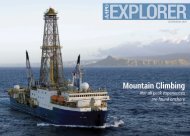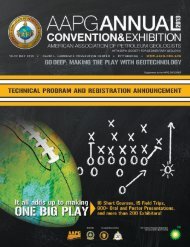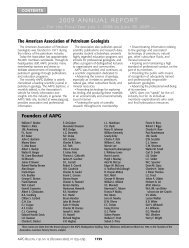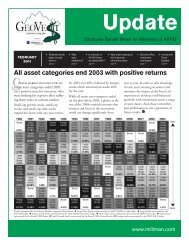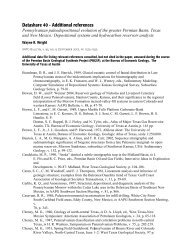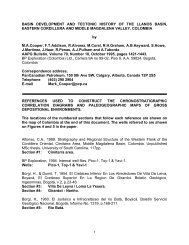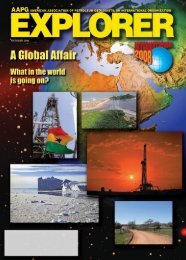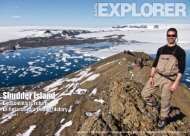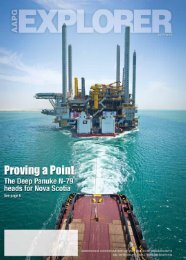president's message - American Association of Petroleum Geologists
president's message - American Association of Petroleum Geologists
president's message - American Association of Petroleum Geologists
You also want an ePaper? Increase the reach of your titles
YUMPU automatically turns print PDFs into web optimized ePapers that Google loves.
December 2008, Vol. 3 http://www.aapg.org/europe/newsletters/index.cfm<br />
TABLE OF CONTENTS<br />
President’s Message 1<br />
Technology Highlights 2<br />
Geosequestation <strong>of</strong> C02 2<br />
Exploration Country Focus 4<br />
The Netherlands 4<br />
Conferences and Seminars 7<br />
AAPG – ER News 9<br />
Calendar 14<br />
AAPG‐ER Structure 15<br />
EDITORIAL BOARD<br />
Hugo Matias, Editor<br />
Pedro Kress, Associate Editor<br />
Claudia Bertoni, Associate Editor<br />
James Bailey, Associate Editor<br />
AAPG European Region Council<br />
Istvan Berczi, President<br />
John Brooks, Past-President<br />
David Richard Cook, President-Elect<br />
Marek H<strong>of</strong>fman, Vice-President<br />
Stuart Harker, European Representative<br />
on the AAPG European Council<br />
Vlastimila Dvorakova,<br />
Secretary/Treasurer<br />
The AAPG European Region Newsletter is<br />
published quarterly by the <strong>American</strong><br />
<strong>Association</strong> <strong>of</strong> <strong>Petroleum</strong> <strong>Geologists</strong> -<br />
European Region, Room 422, Royal School <strong>of</strong><br />
Mines, Department <strong>of</strong> Earth Science &<br />
Engineering, South Kensington Campus,<br />
Imperial College, London, SW7 2AZ, Phone:<br />
+44 207 594 3283<br />
The months <strong>of</strong> issue are March, June,<br />
September and December.<br />
Instructions to authors<br />
Editorial correspondence and material<br />
submitted for publication should be addressed<br />
to the Editor to hmatias@repsol.com. All<br />
materials should be sent by the 15 th <strong>of</strong> the<br />
month before issue publication. All<br />
submissions are subject to editorial review and<br />
revision.<br />
Subscriptions<br />
Subscription to this publication is included in<br />
the membership dues.<br />
Advertising pricing and size<br />
The Newsletter is printed digitally. Advertising<br />
is accepted on a space-available basis.<br />
Deadline for submitting material is 15 th <strong>of</strong> the<br />
month before issue publication.<br />
Advertisement Actual size Front page Random<br />
Page Size<br />
cost<br />
inside cost<br />
Eighth 27.75 x 21.8 $50 $25<br />
Quarter 55.5 x 43 $75 $35<br />
Half 111 x 87.5 Not applicable $75<br />
Full 222 x 175 Not applicable $100<br />
PRESIDENT’S MESSAGE<br />
Dear Readers,<br />
The Late General<br />
DeGAULLE, one <strong>of</strong> the<br />
most charismatic political<br />
leaders <strong>of</strong> Europe in the<br />
second half <strong>of</strong> the 20 th<br />
Century, when asked what<br />
had been the greatest<br />
challenge in his life replied:<br />
“To govern a country with almost<br />
365 different types <strong>of</strong> cheese”.<br />
Looking at developments <strong>of</strong> the global economy in<br />
the past months, including the oil industry, a<br />
modified version <strong>of</strong> this “bon mot” came to my mind<br />
and certainly to most <strong>of</strong> the industry executives’<br />
minds:<br />
“How to govern an industry with future projects<br />
spanning five to thirty years in an economic and<br />
financial environment producing a seventy percent<br />
drop in oil price within 6 months”.<br />
Recently it has been an amusing experience for me<br />
to watch a DVD summary <strong>of</strong> the keynote<br />
presentations <strong>of</strong> the 19 th World <strong>Petroleum</strong> Congress<br />
(Madrid, June 2008) with lengthy lamentations<br />
about the damaging impact <strong>of</strong> the actual<br />
160USD/barrel and future 200 USD/barrel oil price<br />
on the world’s economy… and go back to the hotel<br />
and watch the BBC Newsreel with a dramatic report<br />
about to the adverse impact <strong>of</strong> the extraordinary low<br />
oil price 50 USD/barrel.<br />
Additionally, senior management <strong>of</strong> oil companies<br />
needs to cope with the impact <strong>of</strong> the financial crisis<br />
combined with extra taxes (“Robin Hood” tax) imposed by a<br />
number <strong>of</strong> governments chasing cheap popularity.<br />
Everybody swears that there will be no return to short term<br />
solutions, but realistically thinking, survival in such an<br />
environment demands a reconsideration <strong>of</strong> corporate plans<br />
including CAPEX and OPEX. Unfortunately the usual first<br />
and fastest step is a drastic reduction <strong>of</strong> “s<strong>of</strong>t money”,<br />
including business trips and conference budgets. It is<br />
predictable, that this situation will have an impact upon<br />
scientific organizations including but not limited to the<br />
AAPG.<br />
In this situation, it is very probable that the larger<br />
conferences with more general topics will suffer more than<br />
the specific events focusing on a particular technical subject<br />
or geographical area, as well as training courses. We have to<br />
encourage the decision makers <strong>of</strong> the need to retain skilled<br />
pr<strong>of</strong>essionals and to keep on training young pr<strong>of</strong>essionals. It<br />
must be made clear, that the dramatic shortage <strong>of</strong> skilled<br />
pr<strong>of</strong>essionals endangers a smooth “crew change” and only a<br />
short term reduction in demand for their knowledge and<br />
skill will result from a temporary drop in the number <strong>of</strong> new<br />
projects. Furthermore, the number <strong>of</strong> new projects can not<br />
be kept low for a long time without risking the supply <strong>of</strong> oil<br />
and gas in 10 to 15 years time.<br />
The first reactions <strong>of</strong> responsible leaders in the oil industry<br />
are in line with the above mentioned principles, they want<br />
to maintain long term goals, recruitment, training and<br />
education.<br />
We have to support them to do so.█<br />
István BÉRCZI<br />
President 2007‐2009<br />
AAPG European Region<br />
AAPG‐ER Newsletter – December 2008 1
Geosequestration <strong>of</strong> CO2<br />
Fossil fuels such as coal, oil and natural gas, currently supply around 85 per<br />
cent <strong>of</strong> the world’s energy needs, and according to predictions by the<br />
International Energy Agency, will continue to do so for many years to come.<br />
However, the burning <strong>of</strong> fossil fuels is a major source <strong>of</strong> CO2, the gas most<br />
blamed for the increased concentration <strong>of</strong> greenhouse gases (GHG) in the<br />
atmosphere. Such GHG build‐ups are linked to rapid, human‐induced climate<br />
change, leading to growing public demand for reduction <strong>of</strong> atmospheric GHG<br />
emissions. Most anthropogenic CO2 is emitted by coal fired power plants,<br />
though significant additional CO2 is emitted from production and separation<br />
<strong>of</strong> large CO2 – rich oil and gas accumulations, cement and mineral processing<br />
plants. Carbon management planning will have to include not only the<br />
technical aspects <strong>of</strong> carbon capture, transportation and storage but also issues<br />
<strong>of</strong> public acceptance, environmental, regulatory and liability constraints and<br />
the economics associated with carbon management<br />
There are various suggested options for global GHG reductions, including<br />
improving the conservation and efficiency <strong>of</strong> energy use; utilising non‐fossil<br />
energy forms such as renewables (solar, wind, tidal, nuclear) and increasing<br />
the uptake <strong>of</strong> Carbon Capture and Storage (also known as Geoequestration).<br />
Whilst no one technology will be the “silver bullet” solution to make the<br />
necessary reductions to GHG buildups, a portfolio comprising all the options<br />
will be the most likely response.<br />
Geosequestration is technology that exists today and can be deployed<br />
commercially to make significant cuts in GHG emissions. Geosequestration<br />
involves the long‐term storage <strong>of</strong> captured CO2 emissions in subsurface<br />
geologic formations. The technology comprises a number <strong>of</strong> steps: first, the<br />
CO2 is captured at the source (eg a power plant or gas production facility); the<br />
captured CO2 is then compressed to a supercritical state and transported,<br />
typically via pipeline, from the source to the geologic storage site; next, the<br />
CO2 is injected via conventional wells into the geologic reservoir; and, finally,<br />
the CO2 is stored (trapped) in the geologic reservoir, where any movement is<br />
TECHNOLOGY HIGHLIGHTS<br />
John G. Kaldi<br />
Cooperative Research Centre <strong>of</strong> Greenhouse Gas Technologies (CO2CRC)<br />
Australian School <strong>of</strong> <strong>Petroleum</strong>, The University <strong>of</strong> Adelaide<br />
carefully monitored and the quantity stored is regularly verified.<br />
Commercial‐scale geosequestration projects already exist in several places<br />
around the world. One has been in operation at Statoil’s Sleipner Field in the<br />
Norwegian North Sea since 1996. Other fields <strong>of</strong> note include Algeria’s In<br />
Salah Field (operated by BP, Statoil and Sonatrech) and Encana’s Weyburn<br />
Field in Saskatchewan, Canada, which is using CO2 for EOR operations. At<br />
present, a demonstration‐scale geosequestration project (the CO2CRC<br />
Otway Project) is in progress in Victoria, Australia where a total <strong>of</strong> 100,000<br />
tonnes <strong>of</strong> CO2 is being injected into a depleted gas field.<br />
The storage <strong>of</strong> CO2 involves keeping the CO2 secured deep underground in an<br />
appropriate geologic formation. The main geological conditions for this<br />
include: a porous and permeable reservoir rock, a trap, and an impermeable<br />
caprock. Expertise in locating such formations is well established within the<br />
exploration side <strong>of</strong> the oil and gas business, and geoscientists and engineers<br />
utilise mature technology to identify and evaluate specific sites for their<br />
geosequestration potential. Each site is evaluated for its potential storage<br />
capacity, its potential injectivity and containment properties so as to ensure<br />
that conditions for safe and effective long‐term storage are present.<br />
Since the injected CO2 is originally less dense than the formation water, it will<br />
naturally rise to the top <strong>of</strong> the reservoir, and a trap is needed to ensure that it<br />
does not reach the surface. The most common traps found in Australia are<br />
structural (anticlinal or fault juxtaposition), stratigraphic (pinchout <strong>of</strong><br />
reservoir rock against non‐reservoir) or hydrodynamic (CO2 is entrained in the<br />
groundwater flow and is constrained above and below by impermeable seal<br />
lithologies). An impermeable top seal (caprock) is required to keep the CO2<br />
within the trap. Such seals are generally very fine grained rocks with low<br />
porosity and, even more importantly, low permeability. Typicall caprock are<br />
shales and mudstones. The caprock must be <strong>of</strong> sufficient thickness and<br />
ductility to prevent micr<strong>of</strong>ractures and through‐going faults from developing<br />
as possible CO2 leakage pathways.<br />
Figure 1. A simplified view <strong>of</strong> the steps involved in the geosequestration process (image courtesy <strong>of</strong> CO2CRC)<br />
AAPG‐ER Newsletter – December 2008 2
Active and depleted oil and natural gas fields, which generally have proven<br />
geologic traps, reservoirs and seals are ideal sites for storage <strong>of</strong> injected CO2.<br />
In such fields, it is important to ensure that hydrocarbon resources do not<br />
occur or have already been produced from the specific target formation. Also,<br />
care must be taken that all existing wellbores are adequately cemented with<br />
CO2 resistant cements (to prevent CO2 reaction) before sequestration<br />
operations begin.<br />
Two other important trapping mechanisms, which are not applicable to oil<br />
and gas occurrences but are significant for CO2 storage, are solubility and<br />
mineral trapping. Solubility trapping involves the dissolution <strong>of</strong> CO2 into the<br />
reservoir fluids. Recent research has shown that as the CO2 moves through the<br />
geological formation along the flow path, a proportion <strong>of</strong> the CO2 dissolves in<br />
the formation water. Modelling has shown that with time the CO2 dissolved in<br />
the water increases its density and causes downward fingering <strong>of</strong> CO2 rich<br />
waters. Mineral trapping involves the reaction <strong>of</strong> CO2 with unstable minerals<br />
present in the host formation to form stable, solid compounds such as<br />
carbonates. Once the CO2 has formed such minerals it is permanently locked.<br />
Monitoring <strong>of</strong> the activities <strong>of</strong> stored CO2 includes an extensive array <strong>of</strong><br />
established direct and remote sensing technologies that are deployed on the<br />
surface and in the borehole. These are generally planned for repeat<br />
assessments from a reservoir, containment, wellbore integrity, near surface<br />
and atmospheric perspective. These technologies record properties such as<br />
pressure, temperature, resistivity and sonic responses in both injection and<br />
observation wells. Other monitoring involves seismic, microseismic,<br />
petrophysical well logs and geochemical sampling such as tracer and isotope<br />
analysis will allow tracking <strong>of</strong> movement <strong>of</strong> CO2 in the subsurface. Baseline<br />
Figure 2. Options for the geological storage <strong>of</strong> CO2 (image courtesy <strong>of</strong> CO2CRC)<br />
TECHNOLOGY HIGHLIGHTS<br />
surveys <strong>of</strong> the distribution, type and origin <strong>of</strong> any existing CO2 in a potential<br />
storage site is carried out through soil gas sampling prior to injection. Areal<br />
CO2 migration and trapping are addressed through characterization <strong>of</strong> the<br />
hydrodynamic properties <strong>of</strong> the region. Geochemical sampling at surface<br />
localities will allow rapid detection <strong>of</strong> any seepage or leakage in the unlikely<br />
circumstance that this should occur.<br />
While subsurface storage <strong>of</strong> CO2 is not without risk, a systematic risk<br />
assessment for all geosequestration sites considers both the engineered<br />
and natural systems. The engineered systems consist <strong>of</strong> the wells, the plant<br />
and the gathering line; the natural system includes the geology <strong>of</strong> the site,<br />
the reservoir formation, the overlying and underlying formations and<br />
the groundwater flow regimes. These criteria need to be agreed<br />
in conjunction with the relevant regulatory authorities and apply<br />
to the project through all phases to address responsibilities, liabilities<br />
and to provide assurance <strong>of</strong> safe storage to the satisfaction <strong>of</strong> the public at<br />
large.<br />
In conclusion, successful geosequestration <strong>of</strong> CO2 requires top quality<br />
science, appropriate regulation, clarity on liability issues and acceptance by<br />
the community. Individual storage sites need to be well characterised with<br />
respect to the physical and chemical processes which will take place during<br />
and after injection. Similarly, all the technologies available for monitoring the<br />
stored CO2 need to be evaluated and the most appropriate ones selected and<br />
the risks associated with all phases <strong>of</strong> the process must be identified and<br />
understood. █<br />
Corresponding author: jkaldi@co2crc.com.au<br />
AAPG‐ER Newsletter – December 2008 3
Exploration Country Focus: The Netherlands<br />
INTRODUCTION<br />
With 44 discovered oil fields and 406 discovered gas fields The Netherlands is<br />
typically a gas country. Due to the excellent exploration conditions many<br />
plays can be considered as mature. With major gas reserves and its central<br />
position The Netherlands has been one <strong>of</strong> the major gas exporting countries in<br />
the world for many years. Lately, other countries have passed by the Dutch<br />
who are however still positioned in the top ten (#9 according to BP review<br />
2008).<br />
EXPLORATION AND PRODUCTION HISTORY<br />
Exploration and production during the early 20 th century was primarily<br />
focused on coals in the Southern part <strong>of</strong> the Dutch onshore. Commercial<br />
exploration and production <strong>of</strong> onshore oil and gas fields started only halfway<br />
the previous century and it took until the 1960s that exploration started in the<br />
<strong>of</strong>fshore.<br />
First oil was found in 1923 near Corle in the province <strong>of</strong> Overijssel. In 1938 a<br />
new indication for oil was discovered when a demonstration well drilled in the<br />
centre <strong>of</strong> the city <strong>of</strong> The Hague discovered oil stains at 460m depth. Five years<br />
later, in 1943, the Schoonebeek oil field was discovered, which still is the<br />
largest onshore oil field in Western Europe. The first big oil hit was also the<br />
last, as other oil fields that were found could not be compared to<br />
Schoonebeek in size. Production from the Schoonebeek field was ceased in<br />
1996 after producing 25% <strong>of</strong> the viscous oil. The only Dutch oil field that<br />
comes close to the Schoonebeek field in size is the ‘De Ruyter’ oil field, which<br />
was discovered a few years ago in the southern <strong>of</strong>fshore west <strong>of</strong> The Hague as<br />
a result <strong>of</strong> a high risk exploration strategy. Its production covers nowadays<br />
half <strong>of</strong> the total Dutch oil production (1.49 million Sm3 out <strong>of</strong> 2.5 million Sm3<br />
per year or 9.37 million barrels out <strong>of</strong> 15.64 million barrels per year).<br />
The first commercial gas discovery was made in 1948 Coevorden. Eleven years<br />
later, in 1959, the giant Groningen gas field was discovered in the Permian<br />
Rotliegend sandstones under the province <strong>of</strong> Groningen (Fig. 1). This initiated<br />
large scale gas exploration in The Netherlands. Next year its 50th anniversary<br />
will be celebrated and expectations are that more gas will be recovered from<br />
the field for the next 50 years. Due to the underestimation <strong>of</strong> the size <strong>of</strong> the<br />
field the estimated reserves grew throughout several years to a final GIIP <strong>of</strong><br />
almost 102.5 trillion cubic feet (±17.1 billion b.o.e.). This was the largest known<br />
gas field in the world at the time <strong>of</strong> discovery and is still among the largest.<br />
Due to the excellent reservoir characteristics the Groningen gasfield can be<br />
used as a swing producer, by increasing the production during the winter and<br />
cutting down production during the summer. This is very rare for gas fields <strong>of</strong><br />
this size. With more than 1000 bcm <strong>of</strong> remaining reserves the field is <strong>of</strong> major<br />
importance to the Dutch gas supply.<br />
POLICY<br />
The 1973 oil crisis made the Dutch government more aware <strong>of</strong> the importance<br />
<strong>of</strong> the large reserves <strong>of</strong> the Groningen gas field which could ensure the<br />
country’s energy demand for a very long time. Therefore the Dutch<br />
government developed a policy which is known as the “policy <strong>of</strong> small fields”.<br />
According to this policy exploration for and production from small/medium<br />
sized fields has been encouraged and the Groningen gas field is used as a<br />
swing producer. This will ensure that The Netherlands have a security <strong>of</strong> gas<br />
supply, that small fields will be developed and that international fluctuations<br />
in energy supply have less impact. In this way the Groningen gas field should<br />
exist until the last small gas fields in the Netherlands are exhausted.<br />
EXPLORATION COUNTRY FOCUS<br />
Jaap Breunese & Douwe van Leverink<br />
TNO Built Environment & Geosciences, Advisory Group for the MEA<br />
This policy has lead to the drilling <strong>of</strong> more than 1100 exploration wells and<br />
has proven to be successful in finding new reserves. Of the 406 proven gas<br />
fields (both on‐ and <strong>of</strong>fshore) 215 are in production, 4 are being used for gas<br />
storage, whereas the production from another 60 fields has already ceased<br />
(Fig. 1). The exploration activities have led to an extensive coverage <strong>of</strong> the<br />
Dutch sub surface with 2‐D and 3‐D seismic (3‐D coverage is ca. 56% <strong>of</strong> the<br />
Dutch on‐ and <strong>of</strong>fshore). Together with the thousands <strong>of</strong> exploration and<br />
production wells the Dutch subsurface may be one <strong>of</strong> the best explored.<br />
The Dutch Mining Act implies that copies or samples <strong>of</strong> all data which are<br />
acquired from the subsurface (seismic, drilling results and cores) need to be<br />
handed over to the State. Since 2003 the release period to the public domain<br />
was reduced to 5 years for most <strong>of</strong> the data. Since two years a new website<br />
portal (www.nlog.nl) provides easy access to much <strong>of</strong> this information. In this<br />
way the Dutch E&P market can be more easily approached by new<br />
companies.<br />
Figure 1: Gas and oil accumulations and pipelines in the Netherlands. The<br />
reserves in the Groningen gasfield (indicated with the white arrow) are still<br />
over 1000 bcm (Oil and Gas in The Netherlands, 2008).<br />
AAPG‐ER Newsletter – December 2008 4
AAPG‐ER Newsletter – December 2008<br />
EXPLORATION COUNTRY FOCUS<br />
Figure 2: All gas and oil fields distribution in or close to the Southern Permian Basin. Rotliegend facies distribution is displayed to indicate the basin geometry (from Doornenbal et al., 2009). The colours<br />
represent deposition <strong>of</strong> sediments in fluvial plains (dark blue), dunes (yellow), playa margins and sabkhas (light blue) and lakes (light orange). Be aware that these fields presented are not only situated in<br />
Permian reservoirs.<br />
5
Figure 3: Overview <strong>of</strong> the gas reserves and cumulative production from 1965 to 2008 (Oil and gas in The<br />
Netherlands, 2008).<br />
GEOLOGY AND RESERVOIRS<br />
Hydrocarbon plays in the Netherlands range from Carboniferous to<br />
Quaternary age. The Permian Rotliegend play is by far the most important<br />
comprising 65% <strong>of</strong> the Dutch reserves (even if excluding the Groningen<br />
gasfield) followed by the Triassic play. The Rotliegend play situated in the<br />
Southern Permian Basin (Fig.2) consists <strong>of</strong> aeolian and fluvial sandstones<br />
which are in an almost ideal position above sourcing Westphalian coal<br />
measures (Carboniferous) and below sealing Zechstein salts. The Triassic play<br />
consists <strong>of</strong> single or stacked reservoirs <strong>of</strong> successive sandstone and claystone<br />
formations which have also been sourced by the Westphalian coal measures.<br />
In contrast to e.g. their German neighbours the Dutch are blessed with high<br />
quality reservoirs. As a consequence there is a tendency to only develop<br />
prospects that are not considered or presumed to be ‘tight’. Recovery factors<br />
normally range from 70 to 90% or even exceeding 95% (e.g. the Groningen<br />
field). To give an impression <strong>of</strong> the relative easiness to produce from fields in<br />
the Netherlands, fracjobs have been performed in only 35<br />
production wells.<br />
FUTURE<br />
Because <strong>of</strong> its relative small size, its density <strong>of</strong> population and<br />
the fact that The Netherlands is a low‐lying country there is<br />
continuous concern about possible effects <strong>of</strong> gas production<br />
such as land subsidence and induced microseismicity.<br />
However, policy and ongoing technical development ensure<br />
that gas exploration and production can be continued for many<br />
decades.<br />
The creaming curve shows no creaming <strong>of</strong>f yet, but as the<br />
‘easy fields’ seem to reach their end <strong>of</strong> production and<br />
remaining reserves are declining a new impulse is needed to<br />
develop prospects that have been left aside and to increase<br />
exploration activities (Fig. 3, 4). High oil prices have made NAM<br />
decide to restart the production <strong>of</strong> the heavy oil in the<br />
Schoonebeek field in 2010. On the other side traditionally big<br />
players in The Netherlands like NAM already give signs to<br />
diminish their interest in the Dutch gas production. Their place<br />
can be taken over by players who are more experienced and<br />
willing to produce from difficult reservoirs. Especially<br />
producing from tight reservoirs will be one <strong>of</strong> the main<br />
challenges. A point <strong>of</strong> concern is the timing <strong>of</strong> this change.<br />
AAPG‐ER Newsletter – December 2008<br />
EXPLORATION COUNTRY FOCUS<br />
Large fields are not found anymore, which is also a<br />
result <strong>of</strong> the present low risk drilling strategy <strong>of</strong> the<br />
companies. In the future the development <strong>of</strong> the<br />
smaller fields will only be economically viable when<br />
the present day infrastructure is maintained. This will<br />
require conditions such as high energy prices, a<br />
favorable mining policy and synergy between<br />
different possible users <strong>of</strong> the infrastructure.<br />
Among the interesting new play concepts are the<br />
indications for Early Carboniferous reefs and<br />
recovery <strong>of</strong> shallow gas. Recently Chevron has<br />
successfully started the development <strong>of</strong> a shallow<br />
Plio‐Pleistocene gas field in the Northern Dutch<br />
<strong>of</strong>fshore. This success shows that also this shallow<br />
gas can be produced.<br />
Furthermore, there is increased awareness <strong>of</strong> the fact<br />
that the assets can be <strong>of</strong> economic importance even<br />
after the production <strong>of</strong> hydrocarbons has ended. E.g.<br />
the potential for the use <strong>of</strong> depleted gas fields for the<br />
storage <strong>of</strong> natural gas or CO2 draws attention from<br />
policy makers and industry alike.<br />
Overall the proven reserves are still substantial and<br />
new exploration and production activities will play an important role in The<br />
Netherlands for at least the next twenty years. █<br />
Corresponding author: douwe.vanlevernik@tno.nl<br />
REFERENCES<br />
BP Statistical Review <strong>of</strong> World Energy 2008, www.bp.com<br />
Doornenbal, J.C. et al, 2009. <strong>Petroleum</strong> Geological Atlas <strong>of</strong> the Southern<br />
Permian Basin Area. EAGE Publications b.v.<br />
Oil and Gas in The Netherlands Annual review Exploration and Production 2007<br />
A review <strong>of</strong> oil and gas exploration and production activities during 2007and a<br />
prognosis <strong>of</strong> the production for the period 2008‐2033. www.nlog.nl<br />
Wong, T., Batjes, D.A.J., de Jager, J., 2007. Geology <strong>of</strong> the Netherlands<br />
Figure 4: Creaming curve for the gasfields in the Rotliegend reservoirs, representing the bulk <strong>of</strong> the<br />
Dutch gasfields. (www.nlog.nl)<br />
6
AAPG‐ER Newsletter – December 2008<br />
CONFERENCES AND SEMINARS<br />
INTERNATIONAL WORKSHOP<br />
Geological and bio(geo)chemical processes at cold seeps:<br />
Challenges in recent and ancient systems<br />
Phenomena related to the hydrocarbon migration and gas / fluid seepage<br />
have been recognized and studied worldwide in both recent active and fossil<br />
seep sites in various sedimentological and geodynamic settings. These<br />
locations have a unique potential to study the interaction between the<br />
geosphere and (micro) biosphere and investigate the fingerprinting and<br />
preservation <strong>of</strong> biogeological processes.<br />
Moreover, they can provide a window into the (paleo) fluid flow <strong>of</strong><br />
hydrocarbon‐bearing fluids in different geological contexts. Research on<br />
active cold seeps reveals valuable information on near‐seabed processes,<br />
<strong>of</strong>ten studied with highly advanced analytical techniques. On the contrary,<br />
paleoseeps are logistically easily accessible spots, allowing a detailed study <strong>of</strong><br />
the subsurface seep plumbing system and the heterogeneity <strong>of</strong> complex seep<br />
processes in 4D (space and time).<br />
The goal <strong>of</strong> this workshop is to bring together geologists, geochemists,<br />
microbiologists, biologists, geophysicists and scientists from other disciplines,<br />
both from academy and industry to:<br />
1. define the key research directions, and<br />
2. highlight the new emerging concepts and approaches in the study <strong>of</strong><br />
cold seep systems through geological time.<br />
HOST<br />
The workshop is hosted by The Institut <strong>of</strong> Oceanology “Fridtj<strong>of</strong> Nansen”.<br />
WORKSHOP CONVENERS<br />
Rudy Swennen, K.U. Leuven, Belgium<br />
Lyudomir Dimitrov, IO‐BAS, Bulgaria<br />
Eva De Boever, K.U. Leuven, Belgium<br />
WORKSHOP PROGRAMME<br />
The workshop will be organized as a series <strong>of</strong> round table discussions, starting<br />
from a set <strong>of</strong> specific research questions.<br />
The participants are invited to prepare a presentation formulating a scientific<br />
statement based on their research, which can be used as a base for discussion<br />
and synthesis.<br />
Specific topics to be addressed include (but are not limited to):<br />
- Authigenic seep products<br />
- Tracing the presence, function and activity <strong>of</strong> microbial life at recent and<br />
ancient seep sites<br />
- Fluid flow from source to surface<br />
- Modelling and quantification <strong>of</strong> seep processes<br />
- …<br />
A field trip to the “Pobiti Kamani” paleoseep area (NE Bulgaria) will be<br />
organized before in‐house workshop.<br />
PLACE AND DATE<br />
The International Workshop will be held in Varna / the Resort <strong>of</strong> St.<br />
Konstantin‐Helena, Bulgaria, from Monday, September 28, to Wednesday,<br />
September 30, 2009.<br />
Varna, Bulgaria<br />
28 - 29/09/2009<br />
ACCOMMODATION AND TRANSPORT<br />
Accommodation for all participants will be arranged by the Organizing<br />
Committee. Details will be provided in the Second Circular.<br />
Varna is easily reachable by plane from different European airports either<br />
direct or via S<strong>of</strong>ia ou Bourgas.<br />
REGISTRATION<br />
Details on registration and payment will be given in the Second Circular.<br />
IMPORTANT DATES<br />
16/01/2009 Deadline for preliminary registration<br />
02/02/2009 Distribution <strong>of</strong> Second Circular<br />
20/03/2009 Deadline for registration & abstract submission<br />
25/05/2009 Distribution <strong>of</strong> Workshop programme<br />
For more information please consult: http://ees.kuleuven.be/wvarna09/ or<br />
contact Rudy Swennen (Rudy.Swennen@ees.kuleuven.be) █<br />
7
APPEX London (3 rd -5 th March 2009)<br />
‘The Truly Global A&D Conference’<br />
If your company is either actively or planning to acquire or divest international<br />
upstream assets and is not already sending anyone to attend APPEX in<br />
London in 5 weeks time, perhaps it should.<br />
INTRODUCTION<br />
APPEX will be held again at the North London (Islington) Design Centre,<br />
situated only a couple <strong>of</strong> underground stops from the heart <strong>of</strong><br />
London. APPEX is designed for industry E&P new ventures and business<br />
development decision‐makers from around the world to meet, network and<br />
hopefully lead to successful deals. Feed back by historical participants<br />
confirms its value and the growth <strong>of</strong> attendance expected in 2009<br />
should make the conference a ‘must attend’ annual event for international<br />
deal makers, both big and small. www.appexlondon.com/APPEX09flyer1.pdf<br />
THE PROGRAMME<br />
The newly formatted 2 ½ day speaker programme is also now nearing<br />
completion with some invites still to be accepted. The link should open a copy<br />
<strong>of</strong> the provisional programme should you be interested:<br />
www.envoi.co.uk/APPEX09ProvisionalSpeakerProgramme(Vrn13~26‐1‐09).pdf<br />
THE EXHIBITION & SPONSORSHIP OPPORTUNITIES<br />
The expanded exhibition area is set out to accommodate 75+ booths/stands<br />
with over 40 companies currently registered and new interest being received<br />
PUBLISH WITH THE AAPG-ER Newsletter<br />
AAPG‐ER Newsletter – December 2008<br />
CONFERENCES AND SEMINARS<br />
Mike Lakin<br />
Volunteer Chairman APPEX 09<br />
daily. Prospect exhibitors also have the right to bid for a 10 minute speaker<br />
slot in one <strong>of</strong> the three Prospect Forum sessions which are specifically<br />
designed for companies to present their projects for farmout/divestment.<br />
There are still sponsorship opportunities available too, which I have to admit<br />
has been hit this year due largely to budget constraints. The same cannot be<br />
said for delegate registration which is currently 50% up on the same time last<br />
year. Registration for exhibition booth space and/or sponsorship is outlined in<br />
the following brochure: www.appexlondon.com/ExhibitSalesAPPEX09.pdf<br />
The prices for registration will increase again after the 19 th February so save<br />
money and register soon if you are planning to attend.<br />
ADDITIONAL INFORMATION<br />
The AAPG‐ER Newsletter is the <strong>of</strong>ficial publication for the AAPG European Region members.<br />
We are interested in publishing short papers on recent developments in technology, new<br />
exploratory trends, promotion <strong>of</strong> research projects, conferences, courses and any subject<br />
focused in Europe that is <strong>of</strong> interest for the AAPG members. The Newsletter is received<br />
quarterly online or in print by all members.<br />
For submittal information contact Hugo Matias (hmatias@repsol.com).<br />
The new dedicated APPEX website includes additional information on<br />
registration for both delegates and exhibitors, the programme and hotel<br />
accommodation: www.appexlondon.com.<br />
Feel free to contact me by email or phone should you have any queries.<br />
We very much hope to see you in March. █<br />
8
2009 AAPG Honours and Awards<br />
Stuart Harker<br />
European Representative in the AAPG Advisory Council<br />
The annual Honours and Awards meeting was held 22 August ahead<br />
<strong>of</strong> the AAPG Leadership Days Conference in Tulsa. This year the<br />
European Region had a total <strong>of</strong> 13 nominations for 8 <strong>of</strong> the 11<br />
categories available and this was the most successful year ever for<br />
the European region with 6 successful awardees<br />
Honorary Member Award: Peter A. Ziegler<br />
Distinguished Service Award: Mike J. Lakin<br />
Grover E. Murray Memorial Distinguished Educator Award:<br />
Finn Surlyk<br />
Special Award: Alexei E. Kontorovich and Akif Ali Narimanov<br />
Wallace E. Pratt Memorial Award: Joe Cartwright, Mads<br />
Huuse and Andrew Aplin. █<br />
Welcome to the New Vice-President:<br />
Marek H<strong>of</strong>fman<br />
Ground water hydrologist (University <strong>of</strong> Warsaw) and petroleum<br />
geologist with 38 years <strong>of</strong> experience.<br />
Started his career as a field geologist in various environmental<br />
(tracer technique) applications in Poland and abroad (Kuwait).<br />
In 1990 joined Ministry <strong>of</strong> Environment where he organized Bureau<br />
<strong>of</strong> Geological Concessions, the first modern licensing institution<br />
for minerals in Poland. Special attention was directed on oil and<br />
gas as well as coalbed methane exploration and production.<br />
In 1994 joined Polish Oil and Gas Company (PGNiG SA) to serve as<br />
director <strong>of</strong> different oil and gas exploration units in Poland and<br />
abroad (Pakistan, India). Supervised programming, planning as<br />
well as execution <strong>of</strong> Company’s exploration activities.<br />
In 2006‐7 he was a member <strong>of</strong> negotiating team formed to acquire<br />
development assets at Norwegian Continental Shelf (Skarv). Then<br />
he took part in organization <strong>of</strong> subsidiary company in Norway and<br />
starting October 2007 works as E&P Deputy Manager in PGNiG<br />
Norway AS in Stavanger.█<br />
AAPG‐ER Newsletter – December 2008<br />
AAPG – ER NEWS<br />
New HOD Secretary - Editor (2008 / 2009):<br />
Sigrunn Johnsen<br />
Sigrunn Johnsen, a representative <strong>of</strong> the European Region in the<br />
AAPG House <strong>of</strong> Delegates, has been elected as Secretary/Editor for<br />
the period 2008/2009. She is the first non North‐<strong>American</strong> to have<br />
this position. The European Region is happy to be able to contribute<br />
to the internationalisation <strong>of</strong> AAPG in this manner.<br />
Sigrunn, who is an employee <strong>of</strong> RWE Dea Norway, is presently<br />
working in RWE Dea’s headquarters in Hamburg, Germany in Field<br />
Development, North Africa. █<br />
Energy and Minerals Division in Europe<br />
CALL FOR VOLUNTEERS<br />
AAPG is looking for volunteers to help organize EMD meetings and<br />
activities in Europe. With the increasing dependence on Russian gas<br />
for Europe, and resulting political‐economic difficulties, the time is<br />
ripe for Europe to deepen its portolio <strong>of</strong> energy resources. EMD is<br />
the perfect mechanism for collectively learning from one another<br />
and key leaders in alternative energy on the potential and evolving<br />
technologies for creating viable non‐petroleum energy resources.<br />
Shale gas, coal gas, tight gas sands and other forms <strong>of</strong> energy like<br />
geothermal, oil shales and nuclear energy are already a major part <strong>of</strong><br />
Europe’s energy mix and will only become more important in the<br />
future. If you are interested in helping organize some 2009 meetings<br />
and publications, please contact the EMD European Region<br />
Councilor, John Dolson at jcdolson@aol.com. █<br />
9
Visiting Geoscientists Program<br />
Free University Amsterdam, the Netherlands<br />
Figure 1: From left to right: Ralph Groen (Secretary), Herman Darman (AAPG‐<br />
VGP), Felix Bexkens (Treasure), Thomas Klootwijk (President), Quinten van der<br />
Meer (Vice‐President) and Gideon Lopes Cardozo (AAPG‐VGP).<br />
On 18 September 2008, Gideon Lopes Cardozo and Herman Darman, both<br />
from Shell International E & P, visited the students in the Free University,<br />
Amsterdam. This meeting is intended to found the Amsterdam Student<br />
Chapter <strong>of</strong> the AAPG. Herman explained the goals and objectives <strong>of</strong> the AAPG<br />
and presented some possibilities for activities.<br />
There are about 20 students registered as AAPG members,<br />
and this number is increasing through time. The <strong>of</strong>ficers <strong>of</strong> the student<br />
chapters are: Thomas Klootwijk (President), Felix Bexkens (Treasure), Quinten<br />
van der Meer (Vice‐President), and Ralph Groen (Secretary).<br />
The students in the Free University Amsterdam have organized many<br />
activities over the years. They run a student bar in the university and publish<br />
annual activity books. The students plan to involve the AAPG in their activities<br />
in 2009. █<br />
Figure 2: Amsterdam Free University students show the newly published<br />
annual activity book <strong>of</strong> the geological students.<br />
AAPG‐ER Newsletter – December 2008<br />
AAPG – ER NEWS<br />
Herman Darman<br />
Shell International E&P<br />
Khazar University, Azerbaijan<br />
Figure 3: Visiting Geoscientist Program in Khazar University, Baku,<br />
Azerbaijan. Pr<strong>of</strong>. Rafiq Ahmadov (3rd from left), Herman Darman (AAPG‐<br />
VGP) (4 th from left), Arif Mamed‐zade (5 th from left), with Khazar University<br />
Lecturers and students.<br />
On October 8, 2008, Herman Darman visited Khazar University, 11 Mahsati<br />
Street, Baku, Azerbaijan, as part <strong>of</strong> the AAPG Visiting Geoscientists Program<br />
(VGP). The university has a petroleum engineering program with classes on<br />
petroleum geology. The lectures are given in English. About 25 student came<br />
to attend the technical talk given by Herman titled “<strong>Petroleum</strong> Exploration<br />
and Production Activities in Southeast Asia”. The technical talk was followed<br />
by career discussion.<br />
Khazar University is a private university and is currently establishing a<br />
stronger geosciences department. Soon they will have a new building for the<br />
geoscience department. The AAPG pledged future support with further VGP<br />
presentations and Publication Pipeline donations which will be greatly<br />
appreciated by the university.<br />
During this trip Herman Darman got the opportunity to meet Azerbaijan<br />
Society <strong>of</strong> <strong>Petroleum</strong> Geologist (ASPG) president Dr. Akif Al. Narimanov who<br />
received an AAPG Special Award in 2008. Several potential collaborations<br />
between the AAPG and ASPG were discussed with the ASPG Student<br />
Coordinator: Elshan Abdullayev.<br />
We look forward to working closer on the VGP and Publication Pipeline. The<br />
next VGP will be by Syed Tariq Hasany (Schlumberger – Kazakhstan) in early<br />
2009. █<br />
The main contacts in Khazar University are:<br />
1. Pr<strong>of</strong>. Rafiq Ahmadov, Dean and Head <strong>of</strong> Department<br />
Phone: +994 (0)12 421 7927 (<strong>of</strong>fice)<br />
Mobile: +994 (0)50 633 3221<br />
E‐mail: rahmadov@khazar.org<br />
Website: www.khazar.org<br />
2. Pr<strong>of</strong>. Arif Mamed‐zade, Head <strong>of</strong> Dept. <strong>of</strong> <strong>Petroleum</strong> Engineering<br />
E‐mail: amamedzade@rambler.ru<br />
Azerbaijan Society <strong>of</strong> <strong>Petroleum</strong> Geologist (ASPG) main contacts:<br />
1. Elshan Abdullayev ‐ student coordinator<br />
SOCAR<br />
Tel: +99412 491 9334<br />
Mob: +99450 480 1670<br />
E‐mail: elshanabdullayev@yahoo.com<br />
2. Dr. Akif A. Narimanov – president<br />
SOCAR<br />
Tel: +994 12 5665418<br />
E‐mail: akifnar@socar.baku.az<br />
10
Students Chapters in Europe<br />
AAPG‐ER Newsletter – December 2008<br />
AAPG – ER NEWS<br />
Herman Darman<br />
Shell International E & P<br />
This map shows the distribution <strong>of</strong> the AAPG SC in Europe, with the gaps which lead us to think on how to close. This map is also useful for DL and VGPers who<br />
are going to travel.<br />
If you want to access to the interactive map, please click the following link:<br />
http://maps.google.com/maps/ms?hl=en&ie=UTF8&oe=UTF8&msa=0&msid=107853581758746144562.00045d00702ed770dfed6<br />
Legend: green = active; yellow = pending inactive; red = inactive; blue = universities participating in IBA program<br />
First AAPG Student Chapter in France From IFP School<br />
Luisa Fernanda Zuluaga<br />
Student Chapter Vice-president<br />
2008 Imperial Barrel Award triggers the Students motivation for association and consolidation <strong>of</strong> the first AAPG student chapter in France.<br />
After the IFP school team won second place in the European phase <strong>of</strong> the<br />
Imperial Barrel Award, held in Prague last year, the establishment <strong>of</strong> an active<br />
AAPG student chapter has been <strong>of</strong> great importance to IFP students. This has<br />
now become a reality.<br />
The IFP student chapter was <strong>of</strong>ficially welcomed by the AAPG Students<br />
Affairs <strong>of</strong>fice in July 2008. Since then, the activities <strong>of</strong> the committee have<br />
consisted <strong>of</strong> establishing the association according to French Regulations, and<br />
encouraging students to join the AAPG student chapter. This has resulted in<br />
the majority <strong>of</strong> MSc Students in the IFP <strong>Petroleum</strong> Geosciences program<br />
applying to join, and their membership will be <strong>of</strong>ficial very soon.<br />
Having the support <strong>of</strong> the pr<strong>of</strong>essor Jean‐Pierre Roi as faculty advisor, as well<br />
as the coaching from pr<strong>of</strong>essors François Roure and Alain‐Yves Huc, who are<br />
active members <strong>of</strong> the AAPG community, this years committee (Figure 1) is<br />
very confident on the future success <strong>of</strong> the chapter. The numerous activities<br />
scheduled to take place this year will reinforce the link between the industry<br />
and the IFP student body.<br />
PLANS FOR 2009<br />
The preparation for attending this years “Student chapter convention”,<br />
taking place in Prague in conjunction with the IBA (Imperial Barrel Award)<br />
2009 is the first objective, in order to promote the chapter and develop<br />
projects. Other important objectives will be assisting with the logistics and<br />
preparation for the AAPG European Region Conference to be held in Paris in<br />
November, and finally supporting the team that will participate in this years<br />
IBA. The application for the “Visiting Geoscientist program” and other local<br />
activities are also aims for this year.<br />
In the Long term, this chapter looks to build links with other faculties related<br />
to geosciences throughout the country, in order to strengthen its presence in<br />
France. █<br />
Figure 1. Board members <strong>of</strong> the IFP<br />
School AAPG student chapter –<br />
FRANCE, from left to right:<br />
David Contreras (President); Luisa<br />
Fernanda Zuluaga (Vice‐president);<br />
Raphaël Bouvet (Treasurer); Fishan<br />
Rehman (Secretary)<br />
11
Summary report <strong>of</strong> the 2008 Joint ILP Task Forces workshop<br />
in Ensenada, Mexico<br />
Following the previous successful meetings <strong>of</strong> the ILP Task Force on<br />
Sedimentary Basins, CICESE (Center <strong>of</strong> Scientific Research and Graduate<br />
Studies in Ensenada) and the Mexican Geophysical Union (Unión Ge<strong>of</strong>isica<br />
Mexicana, UGM) hosted this 2008 workshop in Ensenada, Baja California,<br />
Mexico, from September 21 to 26. This workshop, organized by Luis Delgado<br />
(CICESE) and Felipe Ortuño (Instituto Mexicano del Petróleo), involved also<br />
the other ILP Task Forces dealing with mantle processes, volcanism and<br />
paleostress.<br />
60 geologists and geophisicists participated to the meeting, 50% coming from<br />
Mexico and 50% from abroad.<br />
During the opening session, Federico Graef (Director <strong>of</strong> CICESE), Josée<br />
Manuel Romo (Vice‐president <strong>of</strong> UGM), Luis Delgado and Felipe Ortuño<br />
(organizers <strong>of</strong> the workshop), provided the welcome address, which was<br />
followed by an overall presentation <strong>of</strong> ILP and the International Year <strong>of</strong> Planet<br />
Earth by Sierd Cloetingh (President <strong>of</strong> ILP).<br />
Arturo Martin‐Barajas and Ramón Mendoza‐Borunda lead a brilliant field trip<br />
on September 22‐23 across the northern part <strong>of</strong> the Gulf <strong>of</strong> California, from<br />
AAPG‐ER Newsletter – December 2008<br />
AAPG – ER NEWS<br />
François Roure<br />
IFP, Rueil-Malmaison, France<br />
Mexicali to the sea shore, thus allowing to document both low and high‐angle<br />
normal faults, volcanic records <strong>of</strong> the rifting processes, as well as modern<br />
interactions between continental (fluvio‐deltaic) and brackish‐evaporitic<br />
sedimentation. Seismic pr<strong>of</strong>iles and wells data were also helpful in<br />
stimulating in depth discussion on the timing <strong>of</strong> deformation and overall<br />
crustal architecture <strong>of</strong> the basin.<br />
Following the discussions on Mexican basins held during the oral/poster<br />
sessions and the field trip, the last day was mostly devoted to a pannel<br />
discussion (Luis Delgado and Arturo Martin for CICESE, Leni Scheck‐<br />
Wenderoth and Sierd Cloetingh (Panel Chair) for ILP, Kirk Osadetz and Hans<br />
Thybo for Research Institutes and Universities), Noëlle Schoellkopff and<br />
Patrick Unternehr for the Industry), aiming at identifying points <strong>of</strong> common<br />
interest for the Mexican and international Earth Sciences communities, and<br />
defining a road map for further collaborations.<br />
Abstracts have been published in GEOS, volume 28, N°1, 70 pp (September<br />
2008 issue <strong>of</strong> the Journal <strong>of</strong> the Unión Ge<strong>of</strong>ísica Mexicana). A pdf <strong>of</strong> this<br />
volume, which includes also the Field Trip Log, can still be downloaded from<br />
UGM website (www.ugm.org.mx). █<br />
12
The Presidential Tour in Europe<br />
AAPG made history and was part <strong>of</strong> history during AAPG President Scott<br />
Tinker’s recent European Region tour.<br />
The tour, lasting from Sept. 22 to Oct. 2, marked the first‐ever presentation<br />
by an AAPG president to a German geologic association.<br />
Tinker was accompanied by an AAPG delegation comprising European Region<br />
president Istvan Berczi; European Region president‐elect David Cook; and<br />
AAPG Regions and Sections manager Carol McGowen.<br />
The tour began in London, England, and then proceeded to Moscow, Russia;<br />
Aachen, Germany; Kassel, Germany; and Warsaw, Poland. The delegation was<br />
warmly welcomed by their hosts in each city.<br />
While in Aachen, Germany, Tinker became part <strong>of</strong> history as he gave an<br />
address at the opening ceremony <strong>of</strong> a joint conference presented by<br />
Germany’s two oldest geoscience societies. The conference recognized the<br />
160th annual meeting <strong>of</strong> the Deutsche Gesellschaft fur Geowissenschaftern<br />
(German Society for Geosciences, or DGG, founded in 1848), and the 98th<br />
annual meeting <strong>of</strong> the Geologische Vereiningung, a non‐pr<strong>of</strong>it international<br />
earth science organization with more than 1,700 members in over 64<br />
countries.<br />
With the theme <strong>of</strong> Global Energy: Building Bridges for the 21st Century,<br />
Tinker met with <strong>of</strong>ficials and representatives from universities, large national<br />
oil companies or international oil companies in the four countries to promote<br />
collaboration among industry, academia and AAPG.<br />
At each stop along the way, whether the audience was faculty and students or<br />
senior level company leadership, the <strong>message</strong> was consistent.<br />
• Fossil fuels are the bridge to an energy future.<br />
• The cost to reduce carbon in the environment is high – everyone must<br />
participate.<br />
• The developed and developing worlds are interdependent.<br />
• We must find energy solutions that work for the world.<br />
• We must integrate policy, economy and the environment.<br />
• AAPG and other international organizations are the glue with<br />
members world wide from industry, government and academia.<br />
• Collaboration and building bridges are key to the global energy future.<br />
Mutually beneficial rewards and results <strong>of</strong> the tour were many; lively<br />
conversations across the conference table and dinner table helped form new<br />
friendships, develop trust and sow seeds for positive future working<br />
relationships.<br />
Without exception, the AAPG delegation was impressed with a deeper<br />
understanding <strong>of</strong> the historical past and present vitality <strong>of</strong> the energy<br />
industry, people and cities visited.<br />
Through university presentations and informal gatherings with students at all<br />
levels <strong>of</strong> study, existing AAPG student chapters were reinvigorated and<br />
inspiration given to start new student chapters. The delegation learned that<br />
interest is strong to bring AAPG data, education, training opportunities and<br />
publications to companies on the European tour route.<br />
AAPG‐ER Newsletter – December 2008<br />
AAPG – ER NEWS<br />
Carol McGowen<br />
AAPG Regions and Sections Manager<br />
Face‐to‐face communication yielded insight into the unique subject areas<br />
where AAPG can support the work <strong>of</strong> current geoscientists in each company<br />
and society, and future geoscientists in each university.<br />
In turn, AAPG as a global scientific organization will be enhanced through<br />
new partnerships with sister societies, hundreds <strong>of</strong> new student and<br />
corporate AAPG members, and new industry leaders serving on AAPG<br />
committees.<br />
To our hosts and all those who helped organize this historic tour, thank you.█<br />
Here’s the list <strong>of</strong> places (and hosts) visited by AAPG President Scott Tinker<br />
and delegation during a historic tour <strong>of</strong> the European Region.<br />
London, England<br />
• <strong>Petroleum</strong> Group, Geological Society <strong>of</strong> London<br />
• Royal Holloway University <strong>of</strong> London<br />
• Rosneft Oil Company<br />
• Moscow State University<br />
• Lukoil Oil Company<br />
Moscow, Russia<br />
• Gubkin Russian State University <strong>of</strong> Oil and Gas<br />
• Shell Exploration & Production<br />
• TNK‐BP<br />
• ExxonMobil Russia Inc.<br />
• MOL Group<br />
• Gazprom<br />
Aachen, Germany<br />
• Deutsche Gesellschaft fur Geowissenschaftern (DGG)<br />
• Geologische Vereiningung (GV)<br />
• Rheinland‐Westfalien Technische Hochschule (RWTH) Aachen<br />
• Ruhr‐Universitat Bochum<br />
• ExxonMobil Production Deutschland<br />
• Wintershall<br />
Kassel, Germany<br />
Warsaw, Poland<br />
• PGNiG<br />
• University <strong>of</strong> Warsaw<br />
13
January<br />
February<br />
March<br />
April<br />
Mai<br />
June<br />
July<br />
August<br />
September<br />
October<br />
November<br />
December<br />
AAPG‐ER Newsletter – December 2008<br />
1 2 3 4 5 6 7 8 9 10 11 12 13 14 15 16 17 18 19 20 21 22 23 24 25 26 27 28 29 30 31<br />
1 2 3 4 5 6 7 8 9 10 11 12 13 14 15 16 17 18 19 20 21 22 23 24 25 26 27 28<br />
1 2 3 4 5 6 7 8 9 10 11 12 13 14 15 16 17 18 19 20 21 22 23 24 25 26 27 28 29 30 31<br />
8th Annual APPEX (LONDON,<br />
UK)<br />
1 2 3 4 5 6 7 8 9 10 11 12 13 14 15 16 17 18 19 20 21 22 23 24 25 26 27 28 29 30<br />
1 2 3 4 5 6 7 8 9 10 11 12 13 14 15 16 17 18 19 20 21 22 23 24 25 26 27 28 29 30<br />
1 2 3 4 5 6 7 8 9 10 11 12 13 14 15 16 17 18 19 20 21 22 23 24 25 26 27 28 29 30 31<br />
2009 AAPG Annual Convention and<br />
Exhibition (Denver, Colorado, USA)<br />
European <strong>Association</strong> <strong>of</strong> Geoscientists<br />
and Engineers (AMSTERDAM,<br />
NETHERLANDS)<br />
APPL Annual Meeting (CLEARWATER<br />
BEACH, FLORIDA, USA)<br />
1 2 3 4 5 6 7 8 9 10 11 12 13 14 15 16 17 18 19 20 21 22 23 24 25 26 27 28 29 30 31<br />
1 2 3 4 5 6 7 8 9 10 11 12 13 14 15 16 17 18 19 20 21 22 23 24 25 26 27 28 29 30 31<br />
1 2 3 4 5 6 7 8 9 10 11 12 13 14 15 16 17 18 19 20 21 22 23 24 25 26 27 28 29 30 31<br />
AAPG Eastern Section<br />
(EVANSVILLE, INDIANA, USA)<br />
1 2 3 4 5 6 7 8 9 10 11 12 13 14 15 16 17 18 19 20 21 22 23 24 25 26 27 28 29 30 31<br />
3P ‐ Moscow ‐ AAPG<br />
Polar <strong>Petroleum</strong><br />
Potential<br />
(MOSCOW,<br />
RUSSIA)<br />
Asia Pacific Oil & Gas<br />
Conference (SPE) ‐ (JAKARTA,<br />
INDONESIA)<br />
Offshore Europe (SPE)<br />
(ABERDEEN, UK)<br />
2009 AAPG Winter Education Conference<br />
(HOUSTON, TEXAS)<br />
2009 GSA Annual Meeting (PORTLAND,<br />
OREGON, USA)<br />
1 2 3 4 5 6 7 8 9 10 11 12 13 14 15 16 17 18 19 20 21 22 23 24 25 26 27 28 29 30 31<br />
2009 AAPG International Conference &<br />
Exhibition<br />
(RIO DE JANEIRO, BRAZIL)<br />
1 2 3 4 5 6 7 8 9 10 11 12 13 14 15 16 17 18 19 20 21 22 23 24 25 26 27 28 29 30 31<br />
2009<br />
Conferences Course<br />
AAPG Southwest Section Annual<br />
Meeting (MIDLAND, TEXAS, USA)<br />
International<br />
Workshop (Varna,<br />
Bulgaria)<br />
3P ‐ Moscow ‐ AAPG<br />
Polar <strong>Petroleum</strong><br />
Potential<br />
(MOSCOW,<br />
RUSSIA)<br />
SEG International Exposition & 79th Annual Meeting<br />
(HOUSTON, TEXAS, USA)<br />
CALENDAR OF EVENTS<br />
14
AREA COUNCIL<br />
President: Istvan Berczi<br />
MOL Hungarian Oil & Gas plc<br />
iberczi@mol.hu<br />
phone: +36.1.4644653<br />
fax: +36.1.8877579<br />
Past‐President : John Brooks<br />
Brookwood <strong>Petroleum</strong> Advisors, Ltd.<br />
jrvbrooks@supanet.com<br />
phone: +44‐1483‐473285<br />
fax: +44‐1483‐473005<br />
President‐Elect: David Richard Cook<br />
Vice‐President: Marek H<strong>of</strong>fman<br />
European Representative in the AAPG Advisory<br />
Council: Stuart Harker<br />
Circle Oil plc<br />
harker.abz@googlemail.com<br />
Phone : +44‐7825‐187555<br />
Secretary/Treasurer: Vlastimila Dvorakova<br />
Czech Geological Survey<br />
vlastimila.dvorakova@geology.cz<br />
phone : +42‐0543429253<br />
fax : +42‐0543212370<br />
OFFICE (LONDON)<br />
Director: Steve Veal<br />
Room 422, Royal School <strong>of</strong> Mines<br />
Department <strong>of</strong> Earth Science & Engineering<br />
South Kensington Campus<br />
Imperial College<br />
London SW7 2AZ (UK)<br />
europe@aapg.org<br />
Phone: +44 (207) 594 3283<br />
INTERNATIONAL DISTINGUISHED LECTURER<br />
COMMITEE<br />
William Sassi (William@mve.com)<br />
Barbara Davis (bdavis@aapg.org)<br />
Steve Veal (sveal@ix.netcom)<br />
HOUSE OF DELEGATES<br />
SPAIN<br />
Bruce Blake (bblakea@repsol.com)<br />
UNITED KINGDOM<br />
John Brooks (jrvbrooks@supanet.com)<br />
David Jenkins (jenkins@chartwood.com)<br />
Jonathan Redfern<br />
(jonathan.redfern@manchester.ac.uk)<br />
ITALY<br />
Jonathan Craig (jonathan.craig@agip.it)<br />
CZECH REPUBLIC<br />
Vlastimila Dvorakova (dvorakovav@cgu.cz)<br />
SWITZERLAND<br />
Jonathan Green (jonathan.green@ihsenergy.com)<br />
Carol Lucas (lucascjh@bluewin.ch)<br />
GERMANY<br />
Michael Hauck (michael.hauck@wintershall.com)<br />
Martin Jentsch (martin.jentsch@exxonmobil.com)<br />
FRANCE<br />
Alain‐Yves Huc (a‐yves.huc@ifp.fr)<br />
Peter Lloyd (lloyd@rivieramail.com)<br />
François Roure (francois.roure@ifp.fr)<br />
AAPG‐ER Newsletter – December 2008<br />
NORWAY<br />
Sigrunn Johnsen (sigrunn.johnsen@rwedea.com)<br />
POLAND<br />
Rafal Kudrewicz (rafal.kudrewicz@pgnig.com.pl)<br />
RUSSIA<br />
Nikolai Lopatin (nlopatin@mtu‐net.ru)<br />
PORTUGAL<br />
Hugo Matias (hmatias@repsol.com)<br />
NETHERLANDS<br />
Jeroen Peters (jeroen.peters@shell.com)<br />
Alternates<br />
Wolfgang Nachtmann ‐ Austria<br />
Martin Fleckenstein ‐ Germany<br />
John Dolson ‐ Russia<br />
Steve Veal ‐ United Kingdom<br />
Tony Grindrod ‐ United Kingdom<br />
Francisco Porturas ‐ Norway<br />
AFFILIATED SOCIETIES<br />
Asociación de Geólogos y Ge<strong>of</strong>ísicos Españoles del<br />
Petróleo (AGGEP) ‐ SPAIN<br />
Webpage: www.aggep.com<br />
President: Aurelio J. Jiménez Fernández<br />
<strong>Association</strong> <strong>of</strong> <strong>Petroleum</strong> Technicians and<br />
Pr<strong>of</strong>essionals (AFTP) ‐ FRANCE<br />
Webpage: www.aftp.net<br />
President: Isabelle Le Nir<br />
Austrian Geological Society<br />
Webpage: www.geol‐ges.at<br />
President: Christoph Spötl<br />
Azerbeijan <strong>Association</strong> <strong>of</strong> <strong>Petroleum</strong> <strong>Geologists</strong><br />
No current information<br />
Berufsverb and Deutscher Geologen, Geophysiker<br />
und Mineralogen e. V.<br />
Webpage: www.geoberuf.de<br />
e‐mail: BDGBBonn@t‐online.de<br />
Bulgarian Geological Society<br />
Webpage : http://www.bgd.bg/frames_home_EN.html<br />
Czech Geological Society<br />
Webpage: www.geolgickaspolecnostl.cz<br />
e‐mail: budil@cgu.cz<br />
President: Dr. Budil<br />
AAPG – ER STRUCTURE<br />
Energy Institute<br />
Webpage: www.energyinst.org.uk<br />
Norwegian <strong>Association</strong> <strong>of</strong> <strong>Petroleum</strong> <strong>Geologists</strong><br />
Webpage: www.scanviz.org<br />
e‐mail: fr‐po@online.no<br />
President: Francisco Porturas<br />
Tel.: +47 51552566<br />
Mobil: +47 45200830<br />
<strong>Petroleum</strong> Exploration Society <strong>of</strong> Great Britain<br />
Webpage: www.pesgb.org.uk<br />
e‐mail: fr‐po@online.no<br />
President: Francisco Porturas<br />
Tel.: +47 51552566<br />
Mobil: +47 45200830<br />
Polish Geological Society<br />
Webpage: www.pesgb.org.uk<br />
Romanian <strong>Association</strong> <strong>of</strong> <strong>Petroleum</strong> <strong>Geologists</strong><br />
No current information<br />
Royal Geological and Mining Society <strong>of</strong> the<br />
Netherlands<br />
Webpage: www.kngmg.nl<br />
President: P. A. C de Ruiter<br />
Scientific Council for <strong>Petroleum</strong> (Croatia)<br />
No current information<br />
Swiss <strong>Association</strong> <strong>of</strong> <strong>Petroleum</strong> <strong>Geologists</strong> and<br />
Engineers<br />
Webpage: www.vsp‐asp.ch<br />
e‐mail: peterburri@bluewin.ch<br />
President: Peter Burri<br />
Turkish <strong>Association</strong> <strong>of</strong> <strong>Petroleum</strong> <strong>Geologists</strong><br />
Webpage: www.tpdj.org.tr<br />
<strong>Association</strong> <strong>of</strong> Ukrainian <strong>Geologists</strong><br />
No current information<br />
15


